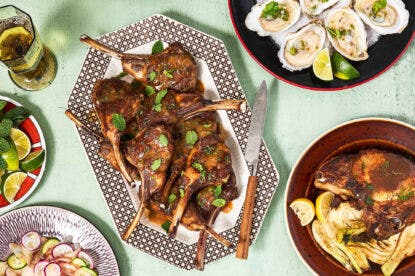Our hot take? It’s not hard to make a great plate of pasta. Pasta-making tips that were once considered revelatory have become second nature for many home cooks. Almost everyone with a television now knows to thoroughly salt the cooking water and reserve some of that salty, starchy water for the sauce. The term “al dente” has become common knowledge among even neophytes. Most of us know not to rinse the noodles and to finish them in the sauce.
But even with all the pasta-making knowledge in the ether (and on the internet), a lot of cooks still can’t reconcile why the pasta they make at home doesn’t live up to the glorious bowls they’ve had in Italy or at top Italian restaurants around the U.S. Fret not, friends: We’re here to help. Or, to be more precise, our panel of pasta experts are here to help.
The tips below will bring you closer to pasta perfection. Whether it’s taking a stab at making fresh pasta without fancy equipment, trying one of the countless brands and shapes of artisanal dried pastas on the market or making the silkiest, most flavorful sauce imaginable, here are culinary professionals’ top secrets for stepping out of your pasta rut.
You May Also Like: Your Official Guide to Cheesy Pasta Wine Pairings
Grab a Bowl and Get Rolling
“I think a lot of people feel that you need some sort of elaborate setup to make fresh pasta, but there isn’t any sort of required tool kit,” says Jacob Siwak, chef-owner of Forsythia in New York City. “All you need is a bowl and a tiny bit of space to make countless types of hand-formed pasta.”
Though there are plenty of skilled chefs and cooks who make intricate pasta shapes, like the beautifully braided lorighittas of Sardinia, Siwak suggests starting with more rustic styles, like ear-shaped orecchiette and rolled cavatelli. They’re sure to taste just as impressive as the fancier forms.

Don’t Sweat Mistakes
“Making fresh pasta is more about confidence than technique,” says Meryl Feinstein, the force behind the @pastasocialclub Instagram account and author of Pasta Every Day. “Know that everything is fixable.” This is especially true for the dough, which is far more forgiving than doughs in baking. Worst-case scenario? An ugly-delicious plate of food.
The Freezer Is Your Friend
Pasta tastes fantastic when it’s fresh. But a quick trip through the freezer isn’t going to have a negative impact. “Freezing fresh pasta locks in its color and texture,” says Feinstein. “Cook a batch of freshly-cut pappardelle alongside one frozen the night before and you’d be hard-pressed to tell the difference.”

Stick to Natural Ingredients
When making vegetable-infused pasta—such as beet ravioli, spinach fettuccine, pumpkin gnocchi, etc.—purée the ingredient and mix it straight into the dough.
“Never cheat with food coloring,” says Domenico Sacramone, chef-owner of Sac’s Place in Astoria, Queens. “It will affect the taste, and the color is just as vibrant and more natural with the real ingredient. Also, don’t be afraid to try making pasta with unusual ingredients: carrot, roasted red pepper, purple yam, red cabbage and turmeric all make vividly colored pasta.”
You May Also Like: The Red Wine Pasta Dough Recipe
Quality In, Quality Out
If you’re not making it from scratch, “buy good pasta!” says Dan Pashman of The Sporkful podcast, author of Anything’s Pastable and creator of the cascatelli pasta shape. “Pasta made with high-quality semolina and a bronze die that’s been slow-dried will give you more margin for error when cooking and be more satisfying to bite into when eating.” His recommendations: the American brand Sfoglini and Rustichella d’Abruzzo from Italy.
The same goes for all the other ingredients, says longtime pasta cook and octogenarian Eleonora Altobelli of Sulmona, Abruzzo. “The quality of your ingredients is more important than following a recipe using inferior ingredients. Whatever is freshest in your garden or at the market can always make a delicious pasta sauce, especially if you have good garlic, cheese and olive oil.”
Go Full Boil
According to the soon-to-debut cookbook The Silver Spoon Pasta: Authentic Italian Recipes: “Only add the pasta when the salted water has reached a rolling boil…Stir immediately, cover the pan and as soon as the water comes back to a boil, remove the lid and leave uncovered.”
The same should be done for filled pastas, says the tome, but it’s important to “remember that the filling adds flavor, so the quantity of salt in the water should be reduced.”
Always al Dente
Cooking pasta al chiodo or al dente can not only help you better enjoy the pasta’s texture, but can be better for your digestion, says author and Italian culinary expert Katie Parla.
“The simple science is that al dente pasta takes longer to chew, which means it spends more time with the enzyme in your saliva that breaks it all down,” she says. “Skip the pasta scotta (overcooked pasta) as the Italians do.”
You May Also Like: An Easy Pasta Recipe with Garlic and Butter for Less Than $15
Make Pasta “Stock”
These days, most people know that adding starchy pasta cooking water to sauce helps it all stick together. The problem is that cooking just one serving of pasta isn’t going to render enough starch to give you restaurant-style results.
To fill in the starch-gap, Kevin O’Donnell, chef-owner of Giusto and Mother’s Pizzeria in Newport, Rhode Island, suggests making what is essentially a pasta stock. Buy some cheap pasta from the store and overcook it in unsalted water (about a gallon for a pound of pasta) until the liquid is viscous and tastes like pasta to use in sauce.
“You can even freeze the pasta stock in ice cube trays because all you need is a little bit,” he says. “Another benefit is now you can really season your pasta cooking water without fear of making your sauce too salty after using some of that water in the cooking process.”
Don’t Let It Simmer
When cooking dried or extruded pasta, it’s important to bring the sauce (more than you think you need) to a vigorous bubble—not just a simmer—before adding the cooked pasta. “When the timing is just right, the pasta will suck up and absorb way more sauce,” says Joe Rolle, the chef-owner of Dario in Minneapolis. “Also, always add the cheese off the heat and never return to heat after cheese is added.”
Just Add Fat
“I have not found a pasta sauce that doesn’t benefit from a couple of cold butter cubes emulsified into it, and then finished with some top shelf extra virgin olive oil,” adds Joe Rolle.
Massimo Vicidomini, executive chef of RPM Italian in Washington, D.C., echoes this sentiment—with one caveat. The Southern Italian chef, for whom pasta is “almost like a religion,” believes that when it comes to seafood pasta, high-quality olive oil is the way to go.
“When you are finishing a seafood pasta, such as spaghetti alle vongole (one of my personal favorites), always add an amazing olive oil at the end while the pan is no longer on the stove,” he says. “Then gently and consistently toss the pasta, which will give it a rich and creamy texture.”
You May Also Like: How to Make the Perfect Cacio e Pepe

Speaking of Texture…
Cheese and cracked pepper are probably the most common pasta toppings in the U.S., but consider doing as the Italians do and add additional flavors and textures to make the dish pop. “Many Italian pasta dishes include crushed nuts, or a topping of pangrattato (seasoned toasted bread crumbs),” says Pashman.
Go Beyond Basic Pesto
“There’s a world of pestos outside of pesto alla Genovese,” says Parla. “In fact, the possibilities for pestos are endless.”
The Rome-based food and beverage writer suggests getting creative with whatever ingredients you may have on hand using the the following formula: one to two bunches of herbs, a cup of nuts, 1/2 cup grated cheese (or salted capers), two garlic cloves and 1/4 cup EVOO. “Just make sure to add the olive oil after blending the other ingredients and stir in the cheese at the very end,” she adds. And “reserve your pasta cooking water to loosen the pesto when making a sauce.”
Published: January 31, 2024














